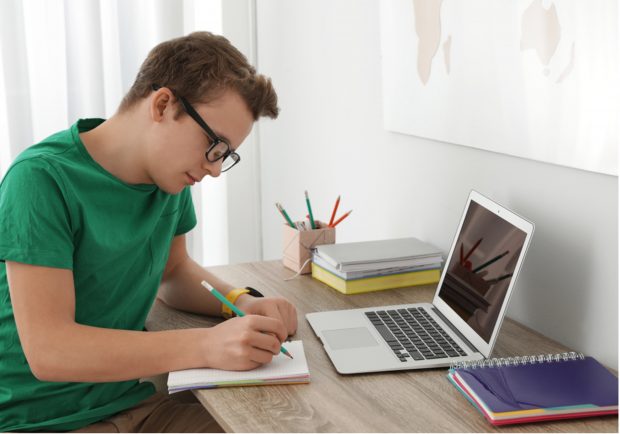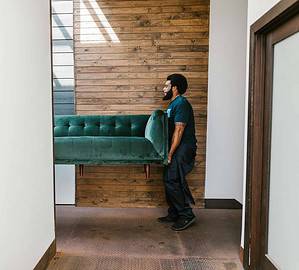These days, it’s possible (and sometimes required) to accomplish a huge range of educational goals from home. But whether you’re studying for nursing school or learning video editing from YouTube tutorials, it’s important to have a space that’s conducive to working hard and achieving at your highest possible level. That’s why many people have found that a home study space is suddenly a must-have.
How can you make sure that your home study space primes you for greatness? Here are seven tips for creating a home study space that aces the test.

Source: BONNINSTUDIO/Shutterstock
1. Choose a space to make your own
Productivity is a mindset, and in order to get there, you need to make a mental association between your space and work. Just the act of sitting down surrounded by your dry erase wall decal, desk lamp and study materials can help mark the mental boundary that you need. But you may be able to reap productivity benefits by setting up physical boundaries as well.
If possible, your study space should be its own room. If you don’t have the luxury of extra space, do whatever you can to define a specific place in your home that’s fully devoted to academic and professional pursuits. In a small space like a studio apartment, that might simply mean something like adding a privacy screen or bead curtain. Anything is better than nothing!
2. Stick with your chosen space as much as possible
The ability to study anywhere is well and good, and it can be a fun change of pace to pull up stakes for a coffee shop, library, co-working space or friend’s house once in a while. But, when in doubt, it’s usually better to continue studying in your designated study space if you can.
That’s because consistency is a key part of studying effectively. The more you’re able to sit down in your purpose-built study space and put yourself into the same zone every day, the more effectively you’ll often be able to master the material. Plus, working in commercial public spaces like coffee shops can get expensive when you factor in the cost of food and beverages.
3. Lighting makes a big difference
If you can swing it, putting your study space somewhere that gets a lot of natural light is ideal. Research shows that natural light is a great way to boost productivity and mood, so even just one window near your study space could make a big difference. If you’re studying in a basement or back bedroom, natural light may not be available, which means you’ll need to figure out a comfortable lighting scheme using artificial light.
While warmer yellow colors are better for relaxing, some studies have shown that it’s better to study or work with cooler colors that mimic natural sunlight. That means choosing lights with a white or blue tint, usually at around 3,500K or above. Whatever you choose, try not to point light directly at your eyes, and consider if you may need a way to cut the glare on your screen.
Source: New Africa/Shutterstock
4. Keep your phone out of the study space as much as possible
Your phone can be a huge distraction from your studies, so figure out somewhere to put it where it will distract you as little as possible. Putting it on silent or somewhere you can’t reach it is good, but putting it on airplane mode or even taking it out of the room entirely is even better.
Sound extreme? Maybe, but some researchers think that even having your phone in your possession can be distracting when you’re trying to learn. You might also find that when you turn your phone off, you become a little more relaxed and able to live in the moment — a win by any standard, whether you’re studying or not.
5. Consider your sonic environment
When it comes to sound while working and studying, everyone prefers something different. Some people need something as close to silence as possible, while others like white noise and still others prefer music. Note, however, that many people find music with lyrics to be too distracting.
The key is to experiment with different approaches to your sonic study space and find the one that works best for your needs. Getting a good pair of noise-canceling headphones is a great investment for many people, and it will help you avoid turning your music up too loud. And if you like music but get lost in the lyrics too easily, try genres like classical or ambient music that focus more on the instrumental side.
6. Decorate for the headspace you want
There’s no reason your study space should be a dour affair. In fact, the more you can do to create a positive and pleasant atmosphere, the more you’ll feel comfortable and motivated when you’re in your study space.
Individual taste means that this part will look quite different for everyone. However, adding elements like treasured photos, favorite pieces of artwork and inspirational quotes can help make your study space more comfortable and motivating. Even some peel and stick wallpaper can be an excellent choice for creating an instant positive atmosphere.
7. Keep your study space exclusive to studying

Source: Dean Drobot/Shutterstock
Try not to do other activities in your study space. If you’re regularly watching TV shows or checking social media in your study space, it can become much harder to resist the temptation to indulge in these things when you’re supposed to be studying. And, conversely, it can become more difficult to get your mind out of the study headspace if you don’t take care to separate these parts of your life.
Naturally, this may not be possible if you’re working with limited indoor space. If that’s the case, you might need to create a study setup that can be dismantled when not in use, such as placing your laptop out of sight and watching Netflix on your TV instead. And whatever you do, don’t study in other areas such as the couch or bed, as this can make it hard to turn off your study mode.




